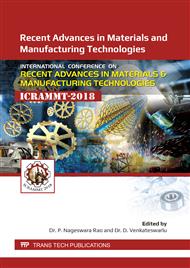[1]
Trochu. F, Ruiz. E, Achim. V, Soukane. S, Advanced numerical simulation of liquid composite molding for process analysis and optimization, Composites Part A: applied science and manufacturing. 37(6) (2006) 890-902.
DOI: 10.1016/j.compositesa.2005.06.003
Google Scholar
[2]
Brouwer. W D, Van Herpt. E.C.F.C, Labordus. M, Vacuum injection moulding for large structural applications, Composites Part A: Applied Science and Manufacturing. 34(6) (2003) 551-558.
DOI: 10.1016/s1359-835x(03)00060-5
Google Scholar
[3]
Yenilmez. B, Sozer. E.M, Compaction of e-glass fabric preforms in the Vacuum Infusion Process, A: Characterization experiments, Composites Part A: Applied Science and Manufacturing. 40(4) (2009) 499-510.
DOI: 10.1016/j.compositesa.2009.01.016
Google Scholar
[4]
Williams. C, Summerscales. J, Grove. S, Resin infusion under flexible tooling (RIFT): a review, Composites Part A: Applied Science and Manufacturing. 27(7) (1996) 517-524.
DOI: 10.1016/1359-835x(96)00008-5
Google Scholar
[5]
Lee. C.L, Wei. K.H, Effect of material and process variables on the performance of resin‐transfer‐molded epoxy fabric composites, Journal of Applied Polymer Science. 77(10) (2000) 2149-2155.
DOI: 10.1002/1097-4628(20000906)77:10<2149::aid-app7>3.0.co;2-j
Google Scholar
[6]
Gokce. A, Chohra. M, Advani. S.G, Walsh. S.M, Permeability estimation algorithm to simultaneously characterize the distribution media and the fabric preform in vacuum assisted resin transfer molding process, Composites Science and Technology. 65(14) (2005) 2129-2139.
DOI: 10.1016/j.compscitech.2005.05.012
Google Scholar
[7]
Correia. N.C, Robitaille. F, Long. A.C, Rudd. C.D, Šimáček. P, Advani. S.G, Analysis of the vacuum infusion moulding process: I. Analytical formulation, Composites Part A: Applied Science and Manufacturing. 36(12) (2005) 1645-1656.
DOI: 10.1016/j.compositesa.2005.03.019
Google Scholar
[8]
Cicala. G, Pergolizzi. E, Piscopo. F, Carbone. D, Recca. G, Hybrid composites manufactured by resin infusion with a fully recyclable bio epoxy resin, Composites Part B: Engineering. 132 (2018) 69-76.
DOI: 10.1016/j.compositesb.2017.08.015
Google Scholar
[9]
C.H. Muralimohan, S. Haribabu, Y.H. Reddy, V. Muthupandi, K. Sivaprasad, Evaluation of microstructures and mechanical properties of dissimilar materials by friction welding, Procedia. Mater. Sci. 5 (2014) 1107-1113.
DOI: 10.1016/j.mspro.2014.07.404
Google Scholar
[10]
C.H. Muralimohan M. Ashfaq, R. Ashiri, V. Muthupandi, K. Sivaprasad, Analysis and characterization of the role of Ni interlayer in the friction welding of titanium and 304 austenitic stainless steel, Metall. Mater. Trans. A. 47 (2016) 347-359.
DOI: 10.1007/s11661-015-3210-z
Google Scholar
[11]
C.H. Muralimohan, V. Muthupandi, K. Sivaprasad, Properties of friction welding titanium-stainless steel joints with a nickel interlayer, Procedia. Mater. Sci. 5 (2014) 1120-1129.
DOI: 10.1016/j.mspro.2014.07.406
Google Scholar
[12]
M. Cheepu, V. Muthupandi, W.S. Che, Improving mechanical properties of dissimilar material friction welds, Appl. Mech. Mater. 877 (2018) 157-162.
DOI: 10.4028/www.scientific.net/amm.877.157
Google Scholar
[13]
C.H. Muralimohan V. Muthupandi, K. Sivaprasad, The influence of aluminium intermediate layer in dissimilar friction welds, Inter. J. Mater. Res. 105 (2014) 350-357.
DOI: 10.3139/146.111031
Google Scholar


